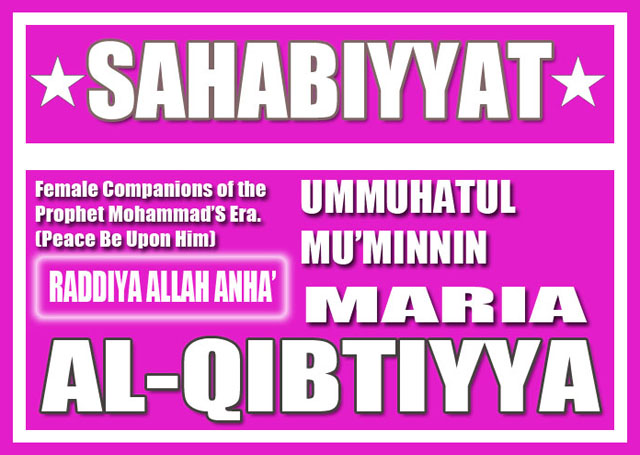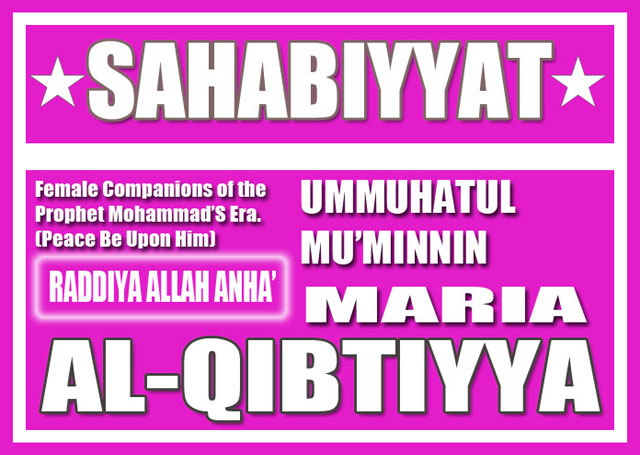Maria Al-Qibtiyya |مارية القبطية
Sahabiyat: Maria Al-Qibtiyya: (Raddiya Allahu Anhà)
(Female Companions of the Prophet Mohammad time)

Egyptian Coptic Christian slave who was sent as a gift from Muqawqis.
Maria al-Qibtiyya (Arabic: مارية القبطية) (alternatively, “Maria Qupthiya”), or Maria the Copt, (died 637) was an Egyptian Coptic Christian slave who was sent as a gift from Muqawqis, a Byzantine official, to the Islamic prophet Muhammad in 628. Many sources, including Ibn Qayyim Al-Jawziyya claim that she was only a concubine. She is also not mentioned in Ibn-Hisham’s notes on Ibn-Ishaq’s biography where he lists the wives of Muhammad.
She was the mother of Muhammad’s son Ibrahim, who died in infancy. Her sister, Sirin, was also sent to Muhammad. Muhammad gave her to his follower Hassan ibn Thabit. Maria never married after Muhammad’s death in 632, and died five years later. Her birthdate is unknown. No primary source mentions her age.
Year of the deputations:
In the Islamic year 6 AH (627 – 628 CE), Muhammad is said to have had letters written to the great rulers of the Middle East, proclaiming the new faith and inviting the rulers to join. What purports to be texts of some of the letters are found in Muhammad ibn Jarir al-Tabari’s History of the Prophets and Kings, which was written some 250 years after the events it chronicled. Tabari writes that a deputation was sent to an Egyptian governor named as al-Muqawqis.
Tabari recounts the story of Maria’s arrival from Egypt
In this year Hātib b. Abi Balta’ah came back from al-Muqawqis bringing Māriyah and her sister Sīrīn, his female mule Duldul, his donkey Ya’fūr, and sets of garments. With the two women al-Muqawqis had sent a eununch, and the latter stayed with them. Hātib had invited them to become Muslims before he arrived with them, and Māriyah and her sister did so. The Messenger of God lodged them with Umm Sulaym bt. Milhān. Māriyah was beautiful. The Prophet sent her sister Sīrīn to Hassān b. Thābit and she bore him ‘Abd al-Rahmān b. Hassān.
Concubine Status
Multiple Scholars and authors have mentioned Maria al-Qibtiyya as one of the concubines (out of four) of Muhammad.
The Prophet (peace and blessings of Allaah be upon him) did not marry Mariyah al-Qibtiyyah, rather she was a concubine who was given to him by al-Muqawqis, the ruler of Egypt. That took place after the treaty of al-Hudaybiyah. Mariyah al-Qibtiyyah was a Christian, then she became Muslim (may Allaah be pleased with her).
- Ibn Saad, The Life of Prophet:
The Messenger of Allaah (peace and blessings of Allaah be upon him) lodged her – meaning Mariyah al-Qibtiyyah and her sister – with Umm Sulaym bint Milhaan, and the Messenger of Allaah (S) entered upon them and told them about Islam. He took Mariyah as a concubine and moved her to some property of his in al-‘Awaali… and she became a good Muslim.
- Al-Tabaqaat al-Kubra, 1/134-135
Mariyah died during the caliphate of ‘Umar ibn al-Khattaab, in Muharram of 16 AH. ‘Umar gathered the people himself to attend her funeral, and he led the funeral prayer for her. She was buried in al-Baqee’.
- Ibn ‘Abd al-Barr, Al-Isti’aab, 4/1912
The Prophet (peace and blessings of Allaah be upon him) had four concubines, one of whom was Mariyah.
- Ibn al-Qayyim , biography
Abu ‘Ubaydah said: He had four (concubines): Mariyah, who was the mother of his son Ibraaheem; Rayhaanah; another beautiful slave woman whom he acquired as a prisoner of war; and a slave woman who was given to him by Zaynab bint Jahsh.
- Zaad al-Ma’aad, 1/114
Maria in Biography of Muhammad
Maria is mentioned with detail in Martin Lings Muhammad: His Life Based on the Earliest Sources. Martin Lings is known as Abu-Bakar Sirajuddin as he converted to Islam. According to the Biography:
Muhammad sent a letter to Muqawqis, summoning him to Islam, was answered evasively; but with his answer the ruler of Egypt sent a rich present of a thousand measures of gold, twenty robes of fine cloth, a mule, a she-ass and, as the crown of the gift, two Coptic Christian slave girls escorted by an elderly eunuch. The girls were sisters, Mariyah and Sirin, and both were beautiful, but Mariyah was exceptionally so, and the Prophet marvelled at her beauty. He gave Sirin to Hassan ibn Thabit, and lodged Mariyah in the nearby house where Safiyyah had lived before.
- Abu Bakar Sirajuddin, Muhammad: His Life Based on the Earliest Sources, LXXI/277-278
- The Author in later chapters gives details of Muhammad’s son (with Maria) Ibrahim and his death.
Maria in Muhammad’s household:
Muhammad lived in a mud-brick dwelling next to the Medina mosque, and each of his wives had her own mud-brick room, built in a line next to his. Maria, however, was lodged in a house on the edge of Medina. Maria is also not listed as a wife in one of the earliest sources, such as Ibn Hisham’s notes on Ibn Ishaq’s Sira.[6] Muslim sources are unanimous in saying that she was accorded the same honor and respect given Muhammad’s wives, pointing out that she was given the same title as Muhammad’s wives – “Mother of the Believers.”
Issue
Maria and Muhammad had one son, Ibrahim who was named after the prophet Ibrahim (Muhammad’s paternal greatest-grandfather ). The boy died when he was sixteen months old. Muhammad was much aggrieved by the loss of his beloved son.




You must be logged in to post a comment.